Fault Reconfiguration in Distribution Networks Based on Improved Discrete Multimodal Multi-Objective Particle Swarm Optimization Algorithm
Abstract
:1. Introduction
- (1)
- Different from previous studies, the current study considers not only the multi-objective in the fault reconfiguration of the distribution network but also its multimodality. Therefore, more equivalent schemes can be provided in the proposed algorithm, which can help decision-makers address the fault reconfiguration problem of distribution networks in uncertain/dynamic environments.
- (2)
- Although various multimodal multi-objective evolutionary algorithms have been proposed in existing studies, most of them are not applicable to solve discrete optimization problems. To alleviate this issue, an improved multimodal multi-objective particle swarm algorithm is proposed in the current study. In the proposed algorithm, the Hamming distance is employed to evaluate the similarity of discrete vectors in the decision space.
2. Fault Reconfiguration Model of Distribution Network
2.1. Objective Function
2.1.1. Power Loss
2.1.2. Voltage Deviation
2.2. Constraints
2.2.1. Power Balance Constraint
2.2.2. Node Voltage Constraint
2.2.3. Branch Current Constraint
2.2.4. Topology Constraint
3. The Proposed Algorithm
3.1. Encoding Method
3.2. Crowding Distance in the Decision Space Based on Hamming Distance
3.3. Environment Selection Method
3.4. Overall Implementation of IDMMPSO Algorithm
| Algorithm 1: Framework of IDMMPSO. |
Input: the size of population: NP; the dimension of particle: D; maximum number of iterations: T;
|
4. Experimental Comparisons and Analysis
4.1. Parameter Settings
4.2. Comparison with Other Competitors
4.3. Multimodality of Solutions
4.4. Computational Time Analysis
5. Conclusions
Author Contributions
Funding
Institutional Review Board Statement
Data Availability Statement
Conflicts of Interest
References
- Mishra, D.K.; Ghadi, M.J.; Azizivahed, A.; Li, L.; Zhang, J. A review on resilience studies in active distribution systems. Renew. Sustain. Energy Rev. 2021, 135, 110201. [Google Scholar] [CrossRef]
- Mishra, S.; Das, D.; Paul, S. A comprehensive review on power distribution network reconfiguration. Energy Syst. 2016, 8, 227–284. [Google Scholar] [CrossRef]
- Akrami, A.; Doostizadeh, M.; Aminifar, F. Optimal reconfiguration of distribution network using μ PMU measurements: A data-driven stochastic robust optimization. IEEE Trans. Smart Grid 2020, 11, 420–428. [Google Scholar] [CrossRef]
- Wang, S.; Wang, Z.; Liu, C.; Hou, H.; Wu, X.; Gao, Q. A review of multi-fault recovery for distribution networks under natural disasters. Procedia Comput. Sci. 2022, 203, 356–361. [Google Scholar] [CrossRef]
- Dorostkar-Ghamsari, M.R.; Fotuhi-Firuzabad, M.; Lehtonen, M.; Safdarian, A. Value of distribution network reconfiguration in presence of renewable energy resources. IEEE Trans. Power Syst. 2015, 31, 1879–1888. [Google Scholar] [CrossRef]
- Capitanescu, F.; Ochoa, L.F.; Margossian, H.; Hatziargyriou, N.D. Assessing the potential of network reconfiguration to improve distributed generation hosting capacity in active distribution systems. IEEE Trans. Power Syst. 2015, 30, 346–356. [Google Scholar] [CrossRef]
- Wang, H.J.; Pan, J.S.; Nguyen, T.T.; Weng, S. Distribution network reconfiguration with distributed generation based on parallel slime mould algorithm. Energy 2022, 244, 123011. [Google Scholar] [CrossRef]
- Badran, O.; Mokhlis, H.; Mekhilef, S.; Dahalan, W. Multi-Objective network reconfiguration with optimal DG output using meta-heuristic search algorithms. Arab. J. Sci. Eng. 2018, 43, 2673–2686. [Google Scholar] [CrossRef]
- Yang, Y.; Liu, Q.; Wu, Y. Research on fault recovery and reconfiguration scheme of distributed generation distribution network. In Proceedings of the 2022 IEEE 5th International Conference on Automation, Electronics and Electrical Engineering (AUTEEE), Shenyang, China, 18–20 November 2022; pp. 450–453. [Google Scholar]
- Mahdavi, E.; Asadpour, S.; Macedo, L.H.; Romero, R. Reconfiguration of Distribution Networks with Simultaneous Allocation of Distributed Generation Using the Whale Optimization Algorithm. Energies 2023, 16, 4560. [Google Scholar] [CrossRef]
- Eldurssi, A.M.; O’Connell, R.M. A fast nondominated sorting guided genetic algorithm for multi-objective power distribution system reconfiguration problem. IEEE Trans. Power Syst. 2014, 30, 593–601. [Google Scholar] [CrossRef]
- Zhong, T.; Zhang, H.; Li, Y.; Liu, L.; Lu, R. Bayesian learning-based multi-objective distribution power network reconfiguration. IEEE Trans. Smart Grid 2020, 12, 1174–1184. [Google Scholar] [CrossRef]
- Nguyen, T.T.; Nguyen, T.T.; Truong, A.V.; Nguyen, Q.T.; Phung, T.A. Multi-objective electric distribution network reconfiguration solution using runner-root algorithm. Appl. Soft Comput. 2017, 52, 93–108. [Google Scholar] [CrossRef]
- Li, L.; Xiong, J.; Tseng, M.; Yan, Z.; Lim, M.K. Using multi-objective sparrow search algorithm to establish active distribution network dynamic reconfiguration integrated optimization. Expert Syst. Appl. 2022, 193, 116445. [Google Scholar] [CrossRef]
- Qi, Q.; Wu, J.; Long, C. Multi-objective operation optimization of an electrical distribution network with soft open point. Appl. Energy 2017, 208, 734–744. [Google Scholar] [CrossRef]
- Fan, Q.Q.; Yan, X.F. Solving Multimodal Multiobjective Problems Through Zoning Search. IEEE Trans. Syst. Man Cybern.-Syst. 2021, 51, 4836–4847. [Google Scholar] [CrossRef]
- Fan, Q.Q.; Ersoy, O.K. Zoning Search With Adaptive Resource Allocating Method for Balanced and Imbalanced Multimodal Multi-Objective Optimization. IEEE-CAA J. Autom. Sin. 2021, 8, 1163–1176. [Google Scholar] [CrossRef]
- Miao, Z.; Huang, W.; Jiang, Q.; Fan, Q. A novel multimodal multi-objective optimization algorithm for multi-robot task allocation. Trans. Inst. Meas. Control. 2023. [Google Scholar] [CrossRef]
- Deb, K.; Pratap, A.; Agarwal, S.; Meyarivan, T. A fast and elitist multiobjective genetic algorithm: NSGA-II. IEEE Trans. Evol. Comput. 2002, 6, 182–197. [Google Scholar] [CrossRef]
- Zitzler, E.; Laumanns, M.; Thiele, L. SPEA2: Improving the strength pareto evolutionary algorithm. Tech. Rep. Gloriastrasse 2001, 5, 103–125. [Google Scholar] [CrossRef]
- Coello, C.C.; Lechuga, M.S. MOPSO: A proposal for multiple objective particle swarm optimization. In Proceedings of the 2002 Congress on Evolutionary Computation. CEC’02 (Cat. No. 02TH8600), Honolulu, HI, USA, 12–17 May 2002; pp. 1051–1056. [Google Scholar]
- Baran, M.E.; Wu, F.F. Network reconfiguration in distribution systems for loss reduction and load balancing. IEEE Trans. Power Deliv. 1989, 4, 1401–1407. [Google Scholar] [CrossRef]
- Zhan, J.; Liu, W.; Chung, C.; Yang, J. Switch opening and exchange method for stochastic distribution network reconfiguration. IEEE Trans. Smart Grid 2020, 11, 2995–3007. [Google Scholar] [CrossRef]
- Sun, Q.; Yu, Y.; Li, D.; Hu, X. A distribution network reconstruction method with DG and EV based on improved gravitation algorithm. Syst. Sci. Control. Eng. 2021, 9, 6–13. [Google Scholar] [CrossRef]
- Yang, J. Research on optimized reconfiguration of distributed distribution network based on ant colony optimization algorithm. In Proceedings of the 2020 International Conference on Computer Engineering and Application (ICCEA), Guangzhou, China, 18–20 March 2020; pp. 20–23. [Google Scholar]
- Kennedy, J.; Eberhart, R.C. A discrete binary version of the particle swarm algorithm. In Proceedings of the 1997 IEEE International Conference on Systems, Man, and Cybernetics. Computational Cybernetics and Simulation, Orlando, FL, USA, 12–15 October 1997; pp. 4104–4108. [Google Scholar]
- Li, X. Niching without niching parameters: Particle swarm optimization using a ring topology. IEEE Trans. Evol. Comput. 2009, 14, 150–169. [Google Scholar] [CrossRef]
- Bookstein, A.; Kulyukin, V.A.; Raita, T. Generalized hamming distance. Inf. Retr. 2002, 5, 353–375. [Google Scholar] [CrossRef]
- Sayeekumar, N.; Karthikeyan, S.P.; Sahoo, S.K.; Raglend, I.J. Graph theory and its applications in power systems-a review. In Proceedings of the 2015 International Conference on Control, Instrumentation, Communication and Computational Technologies (ICCICCT), Kumaracoil, India, 18–19 December 2015; pp. 154–157. [Google Scholar]
- Shirmohammadi, D.; Hong, H.W.; Semlyen, A.; Luo, G.X. A compensation based power flow for weakly meshed distribution and transformation network. IEEE Trans. Power Syst. 1988, 3, 753–762. [Google Scholar] [CrossRef]
- Shahbazi, K. An explicit expression for the penalty parameter of the interior penalty method. J. Comput. Phys. 2005, 205, 401–407. [Google Scholar] [CrossRef]
- Tanabe, R.; Ishibuchi, H. A Review of Evolutionary Multimodal Multiobjective Optimization. IEEE Trans. Evol. Comput. 2020, 24, 193–200. [Google Scholar] [CrossRef]
- Yue, C.; Qu, B.; Liang, J. A multiobjective particle swarm optimizer using ring topology for solving multimodal multiobjective problems. IEEE Trans. Evol. Comput. 2017, 22, 805–817. [Google Scholar] [CrossRef]
- Guerreiro, A.P.; Fonseca, C.M.; Paquete, L. The hypervolume indicator: Computational problems and algorithms. ACM Comput. Surv. 2021, 54, 1–42. [Google Scholar] [CrossRef]
- Zitzler, E.; Thiele, L. Multiobjective optimization using evolutionary algorithms—A comparative case study. In Proceedings of the International Conference on Parallel Problem Solving from Nature, Amsterdam, The Netherlands, 27–30 September 1998; Springer: Berlin/Heidelberg, Germany, 1998; pp. 292–301. [Google Scholar]
- Schott, J.R. Fault Tolerant Design Using Single and Multi-Criteria Genetic Algorithm Optimization. Master’s Thesis, Department of Aeronautics and Astronautics, Massachusetts Institute of Technology, Cambridge, MA, USA, 1995. [Google Scholar]
- Mohammadi, A.; Omidvar, M.N.; Li, X. A new performance metric for user-preference based multi-objective evolutionary algorithms. In Proceedings of the 2013 IEEE Congress on Evolutionary Computation, Cancun, Mexico, 20–23 June 2013; pp. 2825–2832. [Google Scholar]
- Wilcoxon, F. Individual comparisons by ranking methods. Biom. Bull. 1945, 1, 80–83. [Google Scholar] [CrossRef]
- Dolatabadi, S.H.; Ghorbanian, M.; Siano, P.; Hatziargyriou, N.D. An Enhanced IEEE 33 Bus Benchmark Test System for Distribution System Studies. IEEE Trans. Power Syst. 2021, 36, 2565–2572. [Google Scholar] [CrossRef]
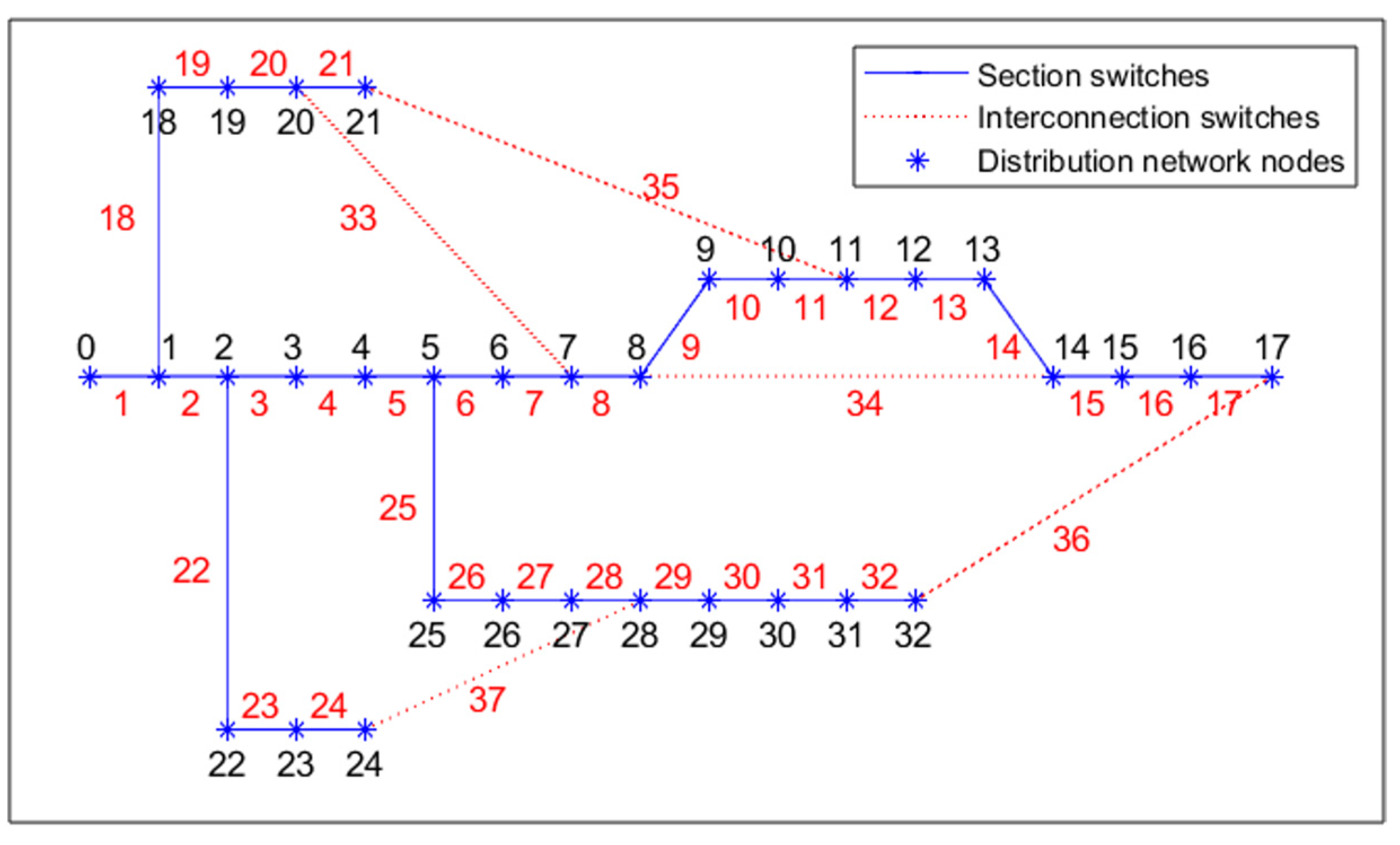
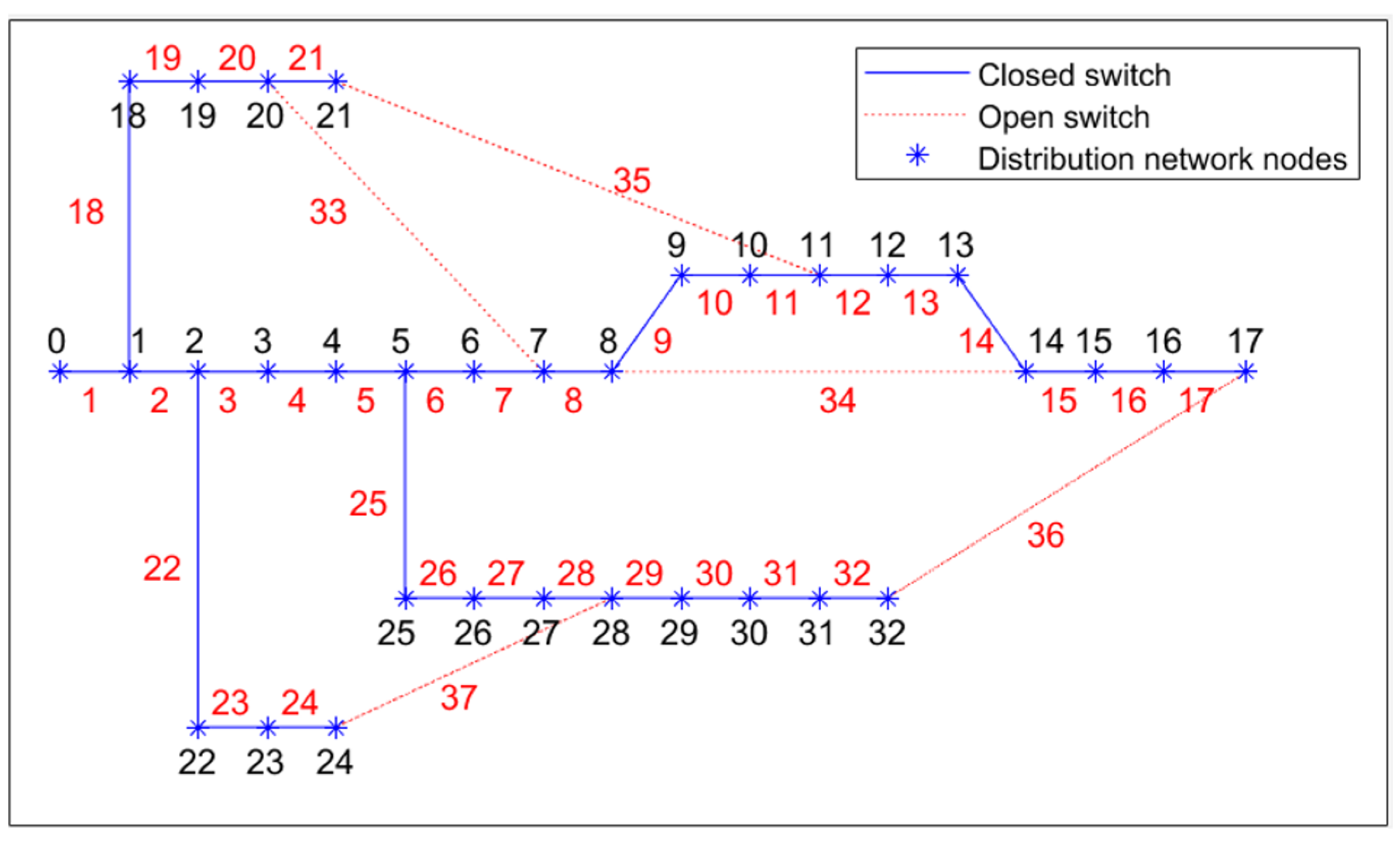
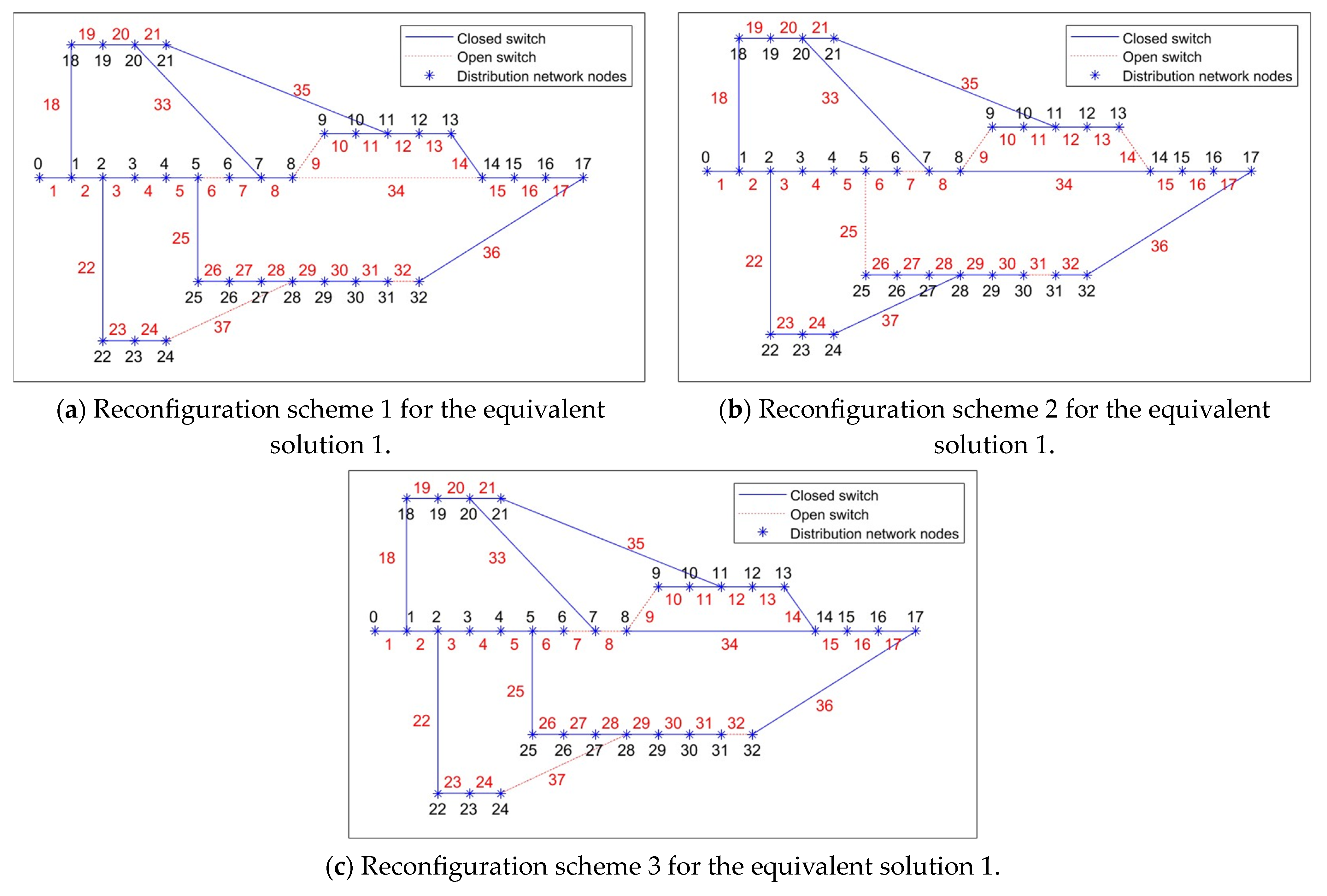

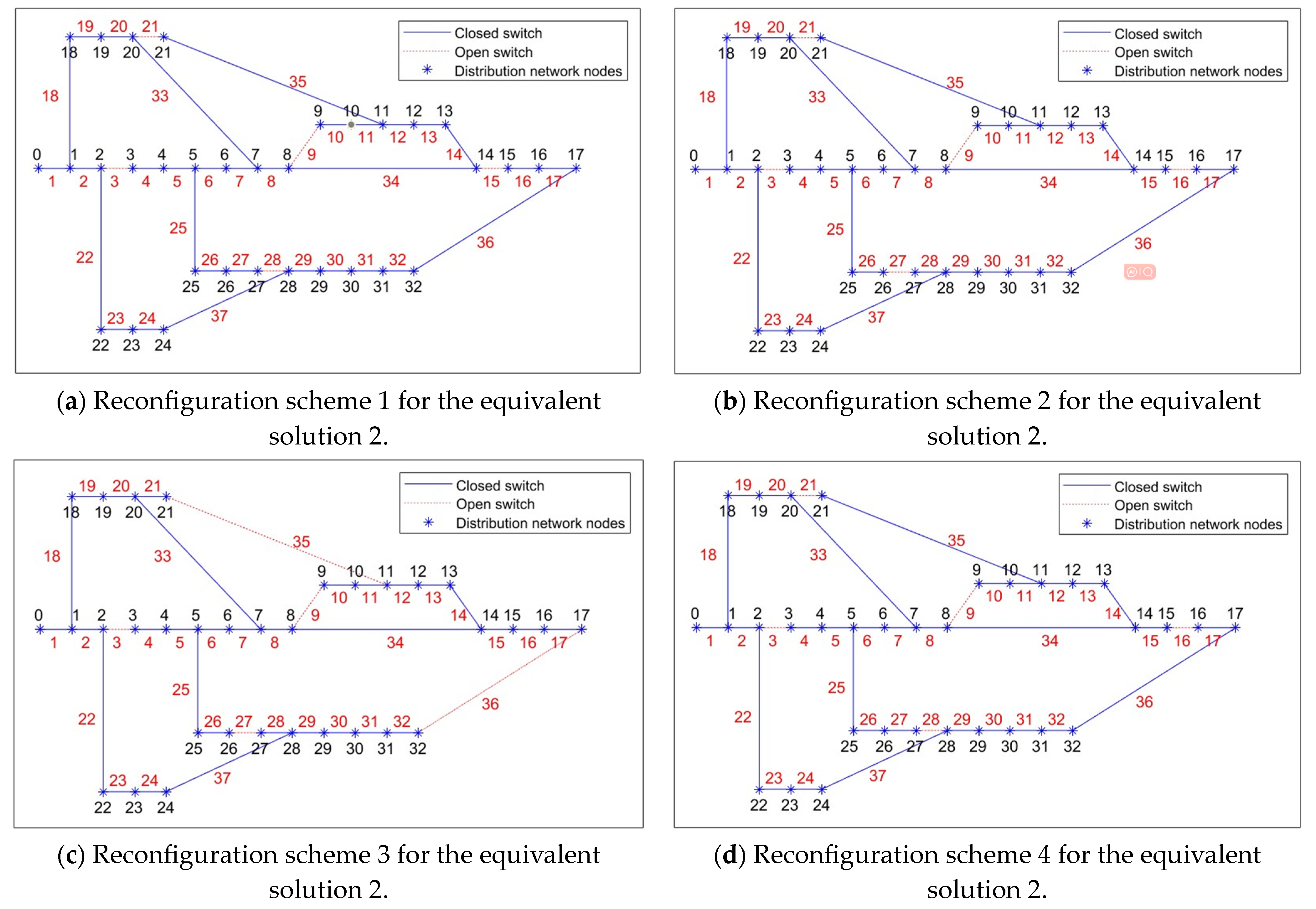
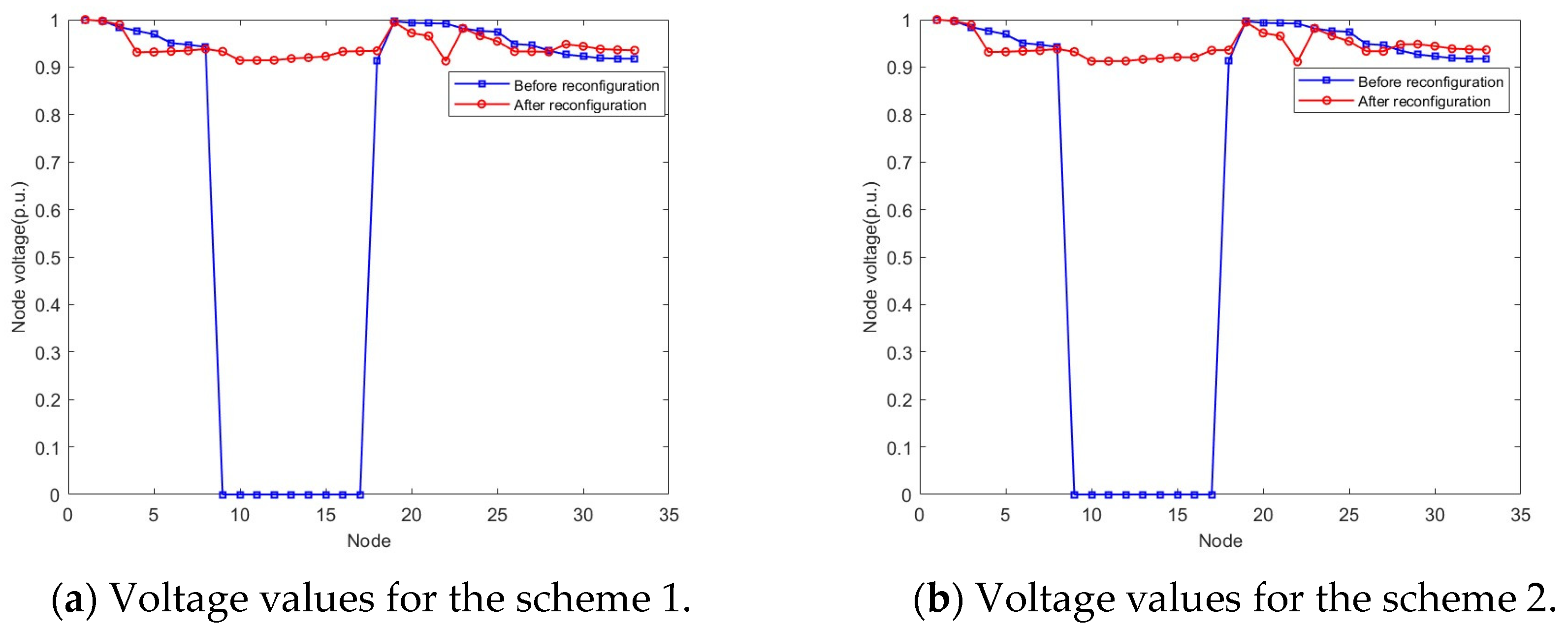
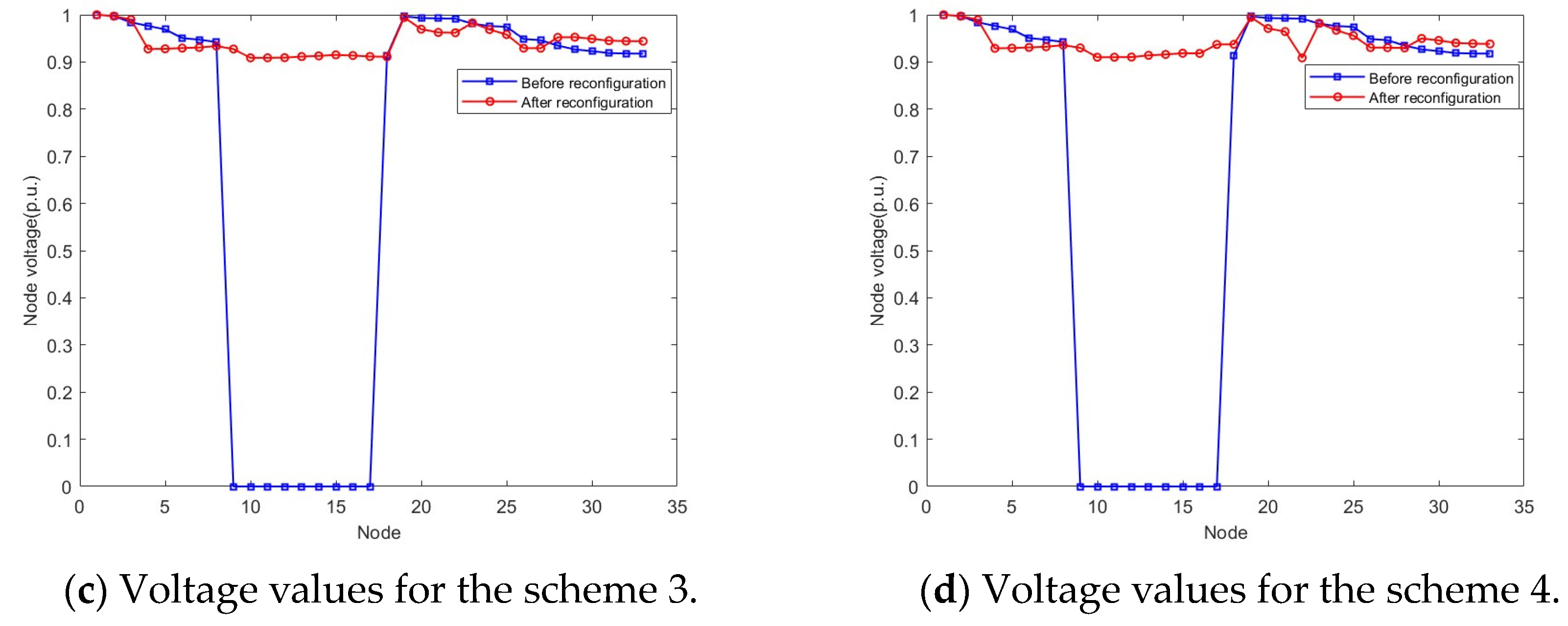
| Metrics | NSGA-II | MOPSO | SPEA2 | IDMMPSO | |||
|---|---|---|---|---|---|---|---|
| IGD-CF | 7.11 × 10−3 (1.56 × 10−3) | + | 5.33 × 10−3 (9.73 × 10−4) | + | 8.92 × 10−3 (1.65 × 10−3) | + | 3.98 × 10−3 (8.22 × 10−4) |
| HV | 6.01 × 10 0 (7.21 × 10−2) | + | 6.04 × 10 0 (4.82 × 10−2) | + | 6.02 × 10 0 (7.34 × 10−2) | + | 6.06 × 10 0 (2.75 × 10−2) |
| C | 9.38 × 10−1 (5.98 × 10−2) | + | 9.71 × 10−1 (5.03 × 10−2) | + | 9.54 × 10−1 (5.74 × 10−2) | + | 9.84 × 10−1 (3.09 × 10−2) |
| SP | 2.28 × 10−2 (3.82 × 10−3) | + | 1.95 × 10−2 (2.58 × 10−3) | + | 2.12 × 10−2 (3.57 × 10−3) | + | 1.77 × 10−2 (3.38 × 10−3) |
| PSP-D | 5.99 × 10 2 (5.20 × 10 1) | + | 7.52 × 10 2 (4.89 × 10 1) | + | 8.13 × 10 2 (5.00 × 10 1) | + | 1.14 × 10 3 (1.37 × 10 2) |
| + | 5 | 5 | 5 | ||||
| − | 0 | 0 | 0 | ||||
| ≈ | 0 | 0 | 0 |
| Solutions | Power Loss/100 kW | Voltage Deviation/p.u. | |||||
|---|---|---|---|---|---|---|---|
| Equivalent solution 1 | 6 | 9 | 32 | 34 | 37 | 1.36 | 1.72 |
| 7 | 9 | 14 | 25 | 31 | 1.37 | 1.71 | |
| 7 | 8 | 9 | 32 | 37 | 1.38 | 1.71 | |
| Equivalent solution 2 | 3 | 9 | 15 | 21 | 28 | 1.91 | 1.07 |
| 3 | 9 | 16 | 21 | 27 | 1.91 | 1.08 | |
| 3 | 9 | 27 | 35 | 36 | 1.89 | 1.08 | |
| 3 | 9 | 16 | 21 | 28 | 1.92 | 1.06 | |
| NSGA-II | MOPSO | SPEA2 | IDMMPSO | |
|---|---|---|---|---|
| The execution time (s) | 35.27 | 64.32 | 63.91 | 59.84 |
| The number of solutions | 36 | 39 | 40 | 51 |
Disclaimer/Publisher’s Note: The statements, opinions and data contained in all publications are solely those of the individual author(s) and contributor(s) and not of MDPI and/or the editor(s). MDPI and/or the editor(s) disclaim responsibility for any injury to people or property resulting from any ideas, methods, instructions or products referred to in the content. |
© 2023 by the authors. Licensee MDPI, Basel, Switzerland. This article is an open access article distributed under the terms and conditions of the Creative Commons Attribution (CC BY) license (https://creativecommons.org/licenses/by/4.0/).
Share and Cite
Li, X.; Li, M.; Yu, M.; Fan, Q. Fault Reconfiguration in Distribution Networks Based on Improved Discrete Multimodal Multi-Objective Particle Swarm Optimization Algorithm. Biomimetics 2023, 8, 431. https://doi.org/10.3390/biomimetics8050431
Li X, Li M, Yu M, Fan Q. Fault Reconfiguration in Distribution Networks Based on Improved Discrete Multimodal Multi-Objective Particle Swarm Optimization Algorithm. Biomimetics. 2023; 8(5):431. https://doi.org/10.3390/biomimetics8050431
Chicago/Turabian StyleLi, Xin, Mingyang Li, Moduo Yu, and Qinqin Fan. 2023. "Fault Reconfiguration in Distribution Networks Based on Improved Discrete Multimodal Multi-Objective Particle Swarm Optimization Algorithm" Biomimetics 8, no. 5: 431. https://doi.org/10.3390/biomimetics8050431
APA StyleLi, X., Li, M., Yu, M., & Fan, Q. (2023). Fault Reconfiguration in Distribution Networks Based on Improved Discrete Multimodal Multi-Objective Particle Swarm Optimization Algorithm. Biomimetics, 8(5), 431. https://doi.org/10.3390/biomimetics8050431







